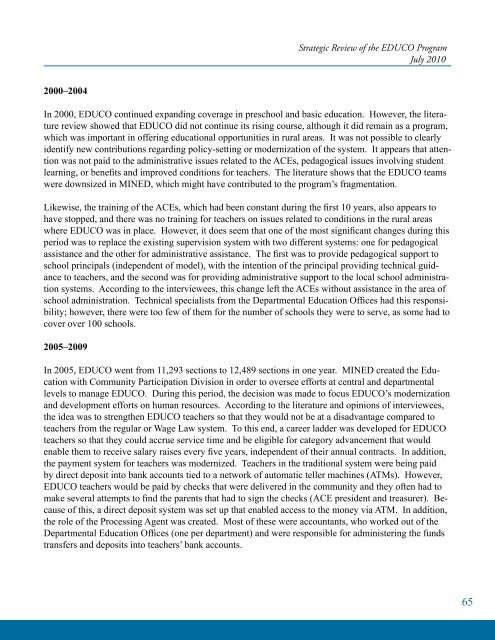Strategic Review of the EDUCO Program - EQUIP123.net
Strategic Review of the EDUCO Program - EQUIP123.net
Strategic Review of the EDUCO Program - EQUIP123.net
You also want an ePaper? Increase the reach of your titles
YUMPU automatically turns print PDFs into web optimized ePapers that Google loves.
<strong>Strategic</strong> <strong>Review</strong> <strong>of</strong> <strong>the</strong> <strong>EDUCO</strong> <strong>Program</strong>July 20102000–2004In 2000, <strong>EDUCO</strong> continued expanding coverage in preschool and basic education. However, <strong>the</strong> literaturereview showed that <strong>EDUCO</strong> did not continue its rising course, although it did remain as a program,which was important in <strong>of</strong>fering educational opportunities in rural areas. It was not possible to clearlyidentify new contributions regarding policy-setting or modernization <strong>of</strong> <strong>the</strong> system. It appears that attentionwas not paid to <strong>the</strong> administrative issues related to <strong>the</strong> ACEs, pedagogical issues involving studentlearning, or benefits and improved conditions for teachers. The literature shows that <strong>the</strong> <strong>EDUCO</strong> teamswere downsized in MINED, which might have contributed to <strong>the</strong> program’s fragmentation.Likewise, <strong>the</strong> training <strong>of</strong> <strong>the</strong> ACEs, which had been constant during <strong>the</strong> first 10 years, also appears tohave stopped, and <strong>the</strong>re was no training for teachers on issues related to conditions in <strong>the</strong> rural areaswhere <strong>EDUCO</strong> was in place. However, it does seem that one <strong>of</strong> <strong>the</strong> most significant changes during thisperiod was to replace <strong>the</strong> existing supervision system with two different systems: one for pedagogicalassistance and <strong>the</strong> o<strong>the</strong>r for administrative assistance. The first was to provide pedagogical support toschool principals (independent <strong>of</strong> model), with <strong>the</strong> intention <strong>of</strong> <strong>the</strong> principal providing technical guidanceto teachers, and <strong>the</strong> second was for providing administrative support to <strong>the</strong> local school administrationsystems. According to <strong>the</strong> interviewees, this change left <strong>the</strong> ACEs without assistance in <strong>the</strong> area <strong>of</strong>school administration. Technical specialists from <strong>the</strong> Departmental Education Offices had this responsibility;however, <strong>the</strong>re were too few <strong>of</strong> <strong>the</strong>m for <strong>the</strong> number <strong>of</strong> schools <strong>the</strong>y were to serve, as some had tocover over 100 schools.2005–2009In 2005, <strong>EDUCO</strong> went from 11,293 sections to 12,489 sections in one year. MINED created <strong>the</strong> Educationwith Community Participation Division in order to oversee efforts at central and departmentallevels to manage <strong>EDUCO</strong>. During this period, <strong>the</strong> decision was made to focus <strong>EDUCO</strong>’s modernizationand development efforts on human resources. According to <strong>the</strong> literature and opinions <strong>of</strong> interviewees,<strong>the</strong> idea was to streng<strong>the</strong>n <strong>EDUCO</strong> teachers so that <strong>the</strong>y would not be at a disadvantage compared toteachers from <strong>the</strong> regular or Wage Law system. To this end, a career ladder was developed for <strong>EDUCO</strong>teachers so that <strong>the</strong>y could accrue service time and be eligible for category advancement that wouldenable <strong>the</strong>m to receive salary raises every five years, independent <strong>of</strong> <strong>the</strong>ir annual contracts. In addition,<strong>the</strong> payment system for teachers was modernized. Teachers in <strong>the</strong> traditional system were being paidby direct deposit into bank accounts tied to a network <strong>of</strong> automatic teller machines (ATMs). However,<strong>EDUCO</strong> teachers would be paid by checks that were delivered in <strong>the</strong> community and <strong>the</strong>y <strong>of</strong>ten had tomake several attempts to find <strong>the</strong> parents that had to sign <strong>the</strong> checks (ACE president and treasurer). Because<strong>of</strong> this, a direct deposit system was set up that enabled access to <strong>the</strong> money via ATM. In addition,<strong>the</strong> role <strong>of</strong> <strong>the</strong> Processing Agent was created. Most <strong>of</strong> <strong>the</strong>se were accountants, who worked out <strong>of</strong> <strong>the</strong>Departmental Education Offices (one per department) and were responsible for administering <strong>the</strong> fundstransfers and deposits into teachers’ bank accounts.65

















